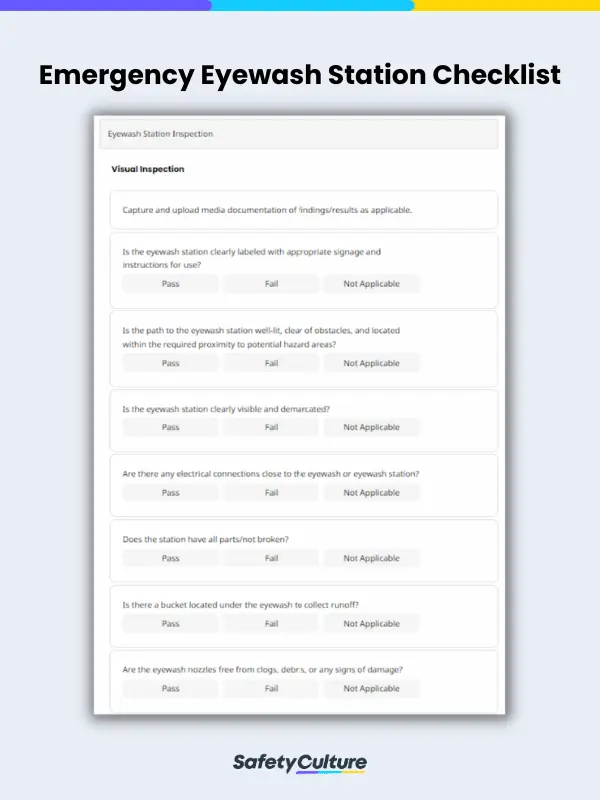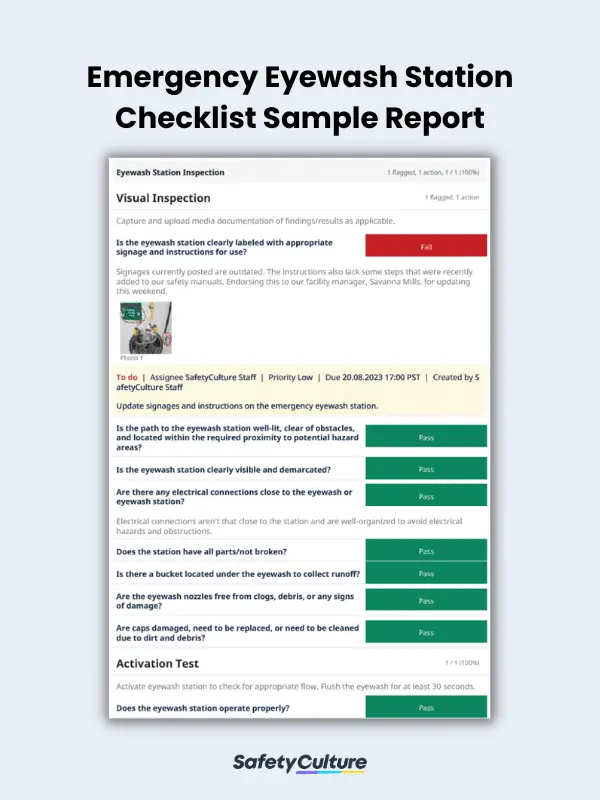What is an Emergency Eye Wash Station Checklist?
An emergency eyewash station checklist is a structured and organized document used to systematically inspect, assess, and ensure the proper functioning and readiness of emergency eyewash stations. The checklist outlines a series of tasks and criteria that need to be evaluated during regular inspections of eyewash stations to ensure they are compliant with safety regulations and capable of providing immediate care in case of eye exposure incidents.
Why Use a Checklist When Inspecting Emergency Eye Wash Stations
When conducting eyewash station inspections, it’s important to follow manufacturer guidelines, industry standards, and any local regulations specific to your region. For example, the US Occupational Safety and Health Administration (OSHA) has set standards and requirements for setting up and maintaining emergency eyewash stations in organizations. With this, it’s important to conduct self-inspections using an OSHA eye wash station inspection checklist to maintain your workers’ safety.
Another key standard to consider is the American National Standard For Emergency Eyewash and Shower Equipment (ANSI/ISEA Z358.1-2014 (R2020)). This provides guidelines for checking eyewash stations’ performance, usage, installation, maintenance, and test procedures.
Also, using a checklist helps inspectors, safety officers, or designated personnel responsible for maintaining workplace safety to ensure workplace safety and compliance. This is made possible by the following benefits:
- Comprehensive Coverage – ensure no critical aspect of the emergency eyewash station goes unnoticed during inspections
- Consistency – reduce the risk of overlooking essential details due to human error or oversight
- Regulatory Compliance – align inspections with industry and regulatory standards to help maintain compliance
- Documentation – provide a documented record of each inspection, including findings and corrective actions taken
- Timely Detection and Resolution – allow inspectors to identify and record issues promptly
- Communication – provide a standardized format for reporting findings, discussing issues, and collaborating on solutions
- Data-Driven Decisions – collect data for analysis to identify trends, recurring issues, or areas for improvement
What Do You Inspect on an Eye Wash Station?
When inspecting an eyewash station, it’s important to assess various aspects, equipment, and installations to ensure it’s properly functioning and ready for use. Make sure to check the following:
- Water Flow and Pressure
- Water Temperature
- Eye Wash Nozzles
- Activation Mechanism
- Flushing Duration
- Fluid Solutions
- Signage and Visibility
- Accessibility
- Cleanliness and Maintenance
What to Include in an Emergency Eye Wash Station Checklist
To help you create a practical checklist for inspecting emergency eyewash stations, make sure to incorporate key elements and sections listed below:
- Title Page
- Date and time of the inspection
- Inspector’s name
- Location/site name
- Visual Inspection
- Checks for physical damages
- Accessibility and visibility of the eyewash station
- Repairs or replacement needs
- Activation Test
- Water temperature
- Checks for leaks
- Flow and pressure
- Completion Page
- Other notes and comments
- Digital signatures
How to Create One
Here’s how you can create a comprehensive emergency eyewash station inspection checklist while carefully considering safety regulations, workplace needs, and potential hazards:
- Determine checklist components and list them accordingly.
- Include clear questions to be answered during the eyewash station inspection. Categorize them into separate sections and provide space for notes or comments.
- Review and test the checklist for accuracy, clarity, and completeness.
- Train designated personnel on how to use the checklist, conduct inspections, and interpret results.
- Collect feedback from inspectors and users, and make necessary adjustments based on their input and changing requirements.
- Review and update the emergency eyewash station checklist periodically to reflect any changes in regulations, equipment, or procedures.
Step-by-Step Guide to Using This Checklist
To guide you, follow these steps in utilizing the checklist when inspecting eyewash stations:
- Start the inspection by locating the eyewash station. Ensure it’s unobstructed, accessible, and clearly labeled with proper signage.
- Perform visual checks, tests, and measurements as needed, and record your observations on the checklist.
- Take photos of any deficiencies or concerns you identify during the inspection to provide visual evidence for documentation.
- If any issues or deficiencies are identified, take appropriate action. This could involve performing minor maintenance, replacing solutions, or initiating a work order for repairs.
- Document any corrective actions you take to address identified deficiencies. Include details of repairs, replacements, or other steps taken to resolve issues. Alternatively, assign actions to responsible personnel if needed.
- Once the inspection is complete and any necessary actions are taken, sign and date the checklist to indicate that the inspection has been conducted and documented.
- Submit the completed checklist to the appropriate department or personnel for timely reporting.
FAQs About Emergency Eye Wash Station Checklists
Yes, you can customize an eyewash station checklist to suit the specific requirements and hazards of your industry. Doing this helps you ensure that it addresses the unique needs and regulatory standards relevant to your workplace or the nature of your work.
Yes, eyewash station checklists can and should be part of an organization’s broader workplace safety protocols. Doing so helps enhance the effectiveness of your safety efforts and ensures that eyewash stations are properly maintained. The use of these checklists must be integrated into the following efforts and initiatives:
- Safety policies and regular safety meetings
- Emergency response plans
- Training and awareness programs
- Incident reporting and investigation
- Data integration and reporting
- Continuous improvement initiatives
- Cross-functional collaboration
- Auditing and compliance checks
- Maintenance and repair protocols
Certainly, there are several common mistakes and pitfalls to be mindful of to ensure the effectiveness of your eyewash station inspections and maintenance. Here are some examples:
- Incomplete and inconsistent inspections
- Not following standards and regulatory requirements
- Neglecting documentation
- Overlooking training and emergency procedures
- Ignoring trend analysis
- No follow-ups on deficiencies
- Lack of accountability
- Not reviewing and updating the checklist




